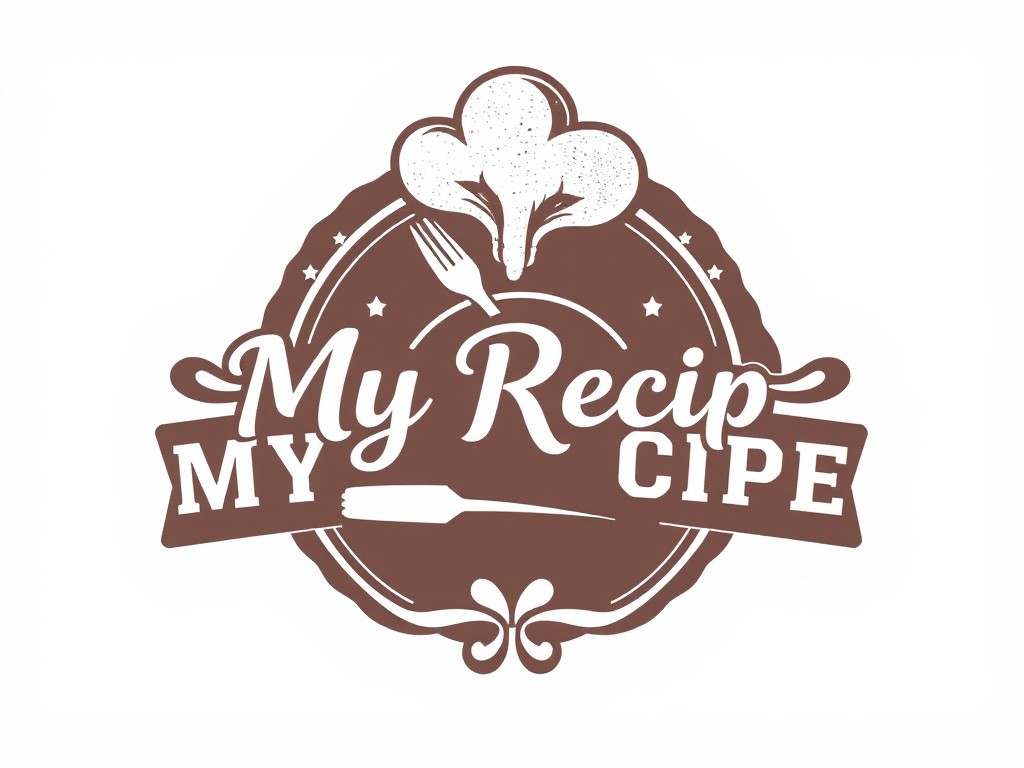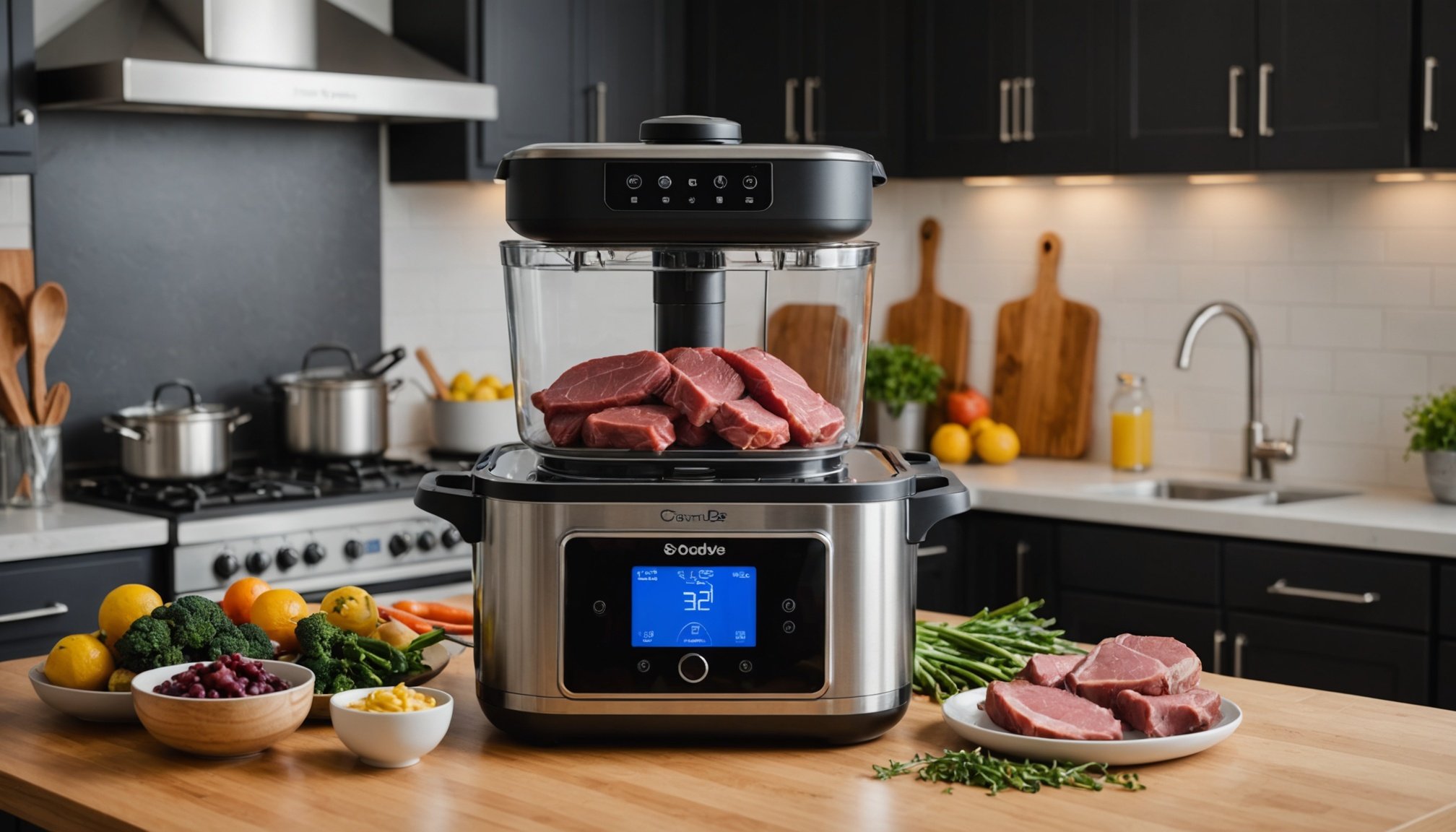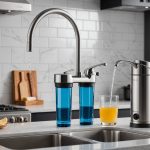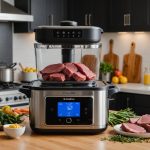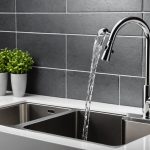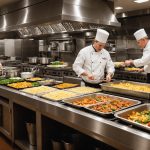Understanding Sous-Vide Cooking
Sous-vide cooking, a culinary technique gaining popularity, involves sealing food in airtight bags and cooking it in temperature-controlled water. Originally devised by French chefs in the 1970s, this cooking method has transformed culinary practices by allowing precise temperature control.
At the heart of sous-vide is the scientific principle of even cooking by preventing overheating. This method ensures that foods retain juiciness and maintain their natural flavours. By eliminating temperature fluctuations common in conventional cooking methods, sous-vide delivers consistent results.
This might interest you : Designing an inclusive kitchen: innovative tips for wheelchair-friendly spaces
The benefits of sous-vide cooking over traditional methods are significant. This approach enhances tenderness, making it ideal for proteins like meats and fish. Additionally, it reduces the risk of overcooking, preserving the desired texture. Moreover, sous-vide allows for greater culinary creativity; ingredients can be infused with diverse flavours, elevating the dining experience to new heights.
Furthermore, sous-vide systems often use less energy compared to traditional ovens or stovetops. This not only makes it appealing for efficient home cooking but also fosters sustainable practices. By mastering this culinary technique, enthusiasts can expand their repertoire and achieve professional-quality dishes with ease.
In parallel : Ultimate kitchen wellness: your comprehensive guide to effortlessly installing a water filtration system
Essential Equipment for Sous-Vide
To achieve the precision cooking technique known for its culinary excellence, having the right sous-vide equipment is essential. Let’s explore the indispensable tools you need for your kitchen.
Immersion Circulators
The heart of any sous-vide setup is the immersion circulator. This device heats and circulates water at exact temperatures, ensuring consistent results. When selecting an immersion circulator, consider factors such as temperature stability, ease of use, and connectivity options. Popular brands include Anova and Joule, known for their reliability and advanced features. Maintaining your circulator routinely—like descaling—helps ensure its longevity.
Vacuum Sealers
A vacuum sealer removes air from the cooking bags, preserving flavours and promoting thorough cooking. Look for models with adjustable suction strengths and sealing settings to accommodate various food types. Foodsaver and Weston are leading brands offering a range of products with desired features. Regular cleaning and checking for gasket wear is crucial for optimal functioning.
Containers and Bags
Select a container large enough to accommodate your food items and circulator. Food-grade polycarbonate containers are popular, but even a deep pot can suffice. For cooking bags, BPA-free options designed specifically for sous-vide are recommended. Proper sealing technique and avoiding contact with the circulator are good practices for these kitchen tools.
Mastering Sous-Vide Techniques
Sous-vide cooking relies heavily on precise temperature control and timing. Mastering these methods elevates one’s cooking proficiency. At its core, sous-vide involves maintaining food at a specific temperature, allowing for thorough cooking without overcooking.
Key Temperature and Timing Principles
When using sous-vide techniques, temperatures often range between 50 to 85 degrees Celsius, depending on the desired doneness and type of food. Meats, for example, benefit from a lower range for tenderness. Timing, equally crucial, can vary vastly. Delicate ingredients like fish need shorter durations; tougher cuts of meat thrive from prolonged submersion.
Common Cooking Techniques
Popular sous-vide techniques include gentle poaching and controlled braising. By using these methods, home chefs can consistently achieve perfect textures and flavours, a feat that’s challenging with traditional cooking. The beauty of sous-vide lies in its ability to cook proteins evenly throughout.
Tips for Desired Doneness and Texture
For achieving the ideal doneness, certain tips can be helpful. Seal food tightly to prevent water ingress and ensure even cooking. Familiarise yourself with how different cooking times affect texture. With practice, these sous-vide techniques can significantly enhance your overall cooking proficiency.
Delicious Sous-Vide Recipes to Try
Discovering new sous-vide recipes can be an exciting culinary journey, offering an array of flavours and textures. Whether you’re new to sous-vide or a seasoned pro, these dishes provide ample culinary inspiration.
Meat Dishes
In the world of meat dishes, sous-vide delivers unmatched tenderness. Imagine a perfectly cooked sous-vide steak that melts in your mouth. Start with a 2-inch thick ribeye, seasoned with salt and pepper. Seal it in a vacuum bag with a sprig of thyme, a clove of garlic, and butter, then sous-vide at 130°F for 2 hours. The result is robust, capturing all the juices inside.
Vegetables and Side Dishes
Sous-vide isn’t just for meats; vegetables shine too. Consider carrots cooked with honey and ginger. Seal them with a splash of olive oil and a pinch of salt. Bath them in 185°F water for 45 minutes. They emerge vibrant, retaining their nutrients and flavour.
Desserts
For desserts, sous-vide offers smooth and creamy custards. A luxurious vanilla custard can be yours by blending eggs, cream, sugar, and vanilla to a smooth consistency. Pour the mixture into jars, sealing tightly. Cook in a 179°F bath for an hour. It’s a delightful finish to any meal.
Experimenting with these recipes not only enhances meal preparation but also provides nutritional benefits by preserving flavours and vitamins. Enjoy the journey!
Integrating Sous-Vide into Your Daily Cooking
Incorporating sous-vide into your daily meal planning can dramatically streamline your cooking process. Start by designating one day a week for sous-vide meal prep, allowing you to create a variety of dishes that can be quickly finished using other cooking methods throughout the week.
Combining sous-vide with traditional techniques, such as roasting or grilling, enhances flavours and textures. For example, sous-vide a chicken breast to retain moisture, then finish it with a quick sear on the grill for a smoky, crispy finish.
Effective time management is key in any home cooking routine, and sous-vide can boost your efficiency. Prepare multiple vacuum-sealed bags with proteins and vegetables in advance. This way, you can pop them into the sous-vide bath while you tend to other tasks, knowing precise temperatures ensure perfectly cooked results every time.
Maximising kitchen efficiency also involves using downtime wisely. As sous-vide works its magic, utilise this period to prepare sides or desserts, consolidating your efforts and minimising active cooking time. Embracing these strategies can make your home cooking both a delicious and enjoyable experience.
Troubleshooting and Frequently Asked Questions
For beginners in sous-vide cooking, challenges can arise, yet they are often straightforward to resolve. A frequent concern is inconsistent cooking temperature. Ensure that your water bath maintains a steady temperature, using a proper immersion circulator. Overcrowding the cooking container can also prevent even cooking, so it’s best to avoid overloading.
Common FAQs of sous-vide cooking include:
-
Can I sous-vide frozen foods? Yes, you can cook frozen foods directly using sous-vide. Simply add extra cooking time to account for the initial freezing.
-
Why is my food mushy? This may occur from leaving food in the water bath too long or setting the temperature too high. Monitoring and adjusting these variables is crucial.
For those eager to learn more, there are many resources available. Online forums and cooking groups can provide community support. Books and reputable culinary websites offer in-depth guides and recipes.
By addressing these common issues, trial and a little patience can unlock the full potential of sous-vide cooking. Find comfort in knowing you’re not alone in this journey, and there’s ample support available to enhance your cooking skills.
Nutritional Benefits and Health Considerations
Sous-vide cooking, a method where food is vacuum-sealed and cooked in a temperature-controlled water bath, offers numerous health benefits. By regulating temperature precisely, this technique preserves more nutrients compared to traditional cooking methods, which often involve higher temperatures that can degrade vitamins and minerals.
One of the key benefits of sous-vide cooking is its ability to enhance meal flavours while retaining essential nutrients. The vacuum-sealing process locks in juices and flavours, resulting in tender and flavorful dishes. This not only improves the taste but ensures that vital nutrients, usually lost through high-heat cooking, are better retained.
Cooking safely is paramount when using the sous-vide method. To maximise food safety, it is important to follow temperature guidelines carefully. Ensuring the water bath reaches the correct temperatures is crucial for avoiding the growth of harmful bacteria. It’s also vital to use proper vacuum-sealed bags designed for sous-vide to avoid any chemical leaching into the food.
Understanding how sous-vide can transform your meals while prioritising nutrition and safety can greatly enhance your culinary experience, providing both vibrant flavours and nutritional integrity.
